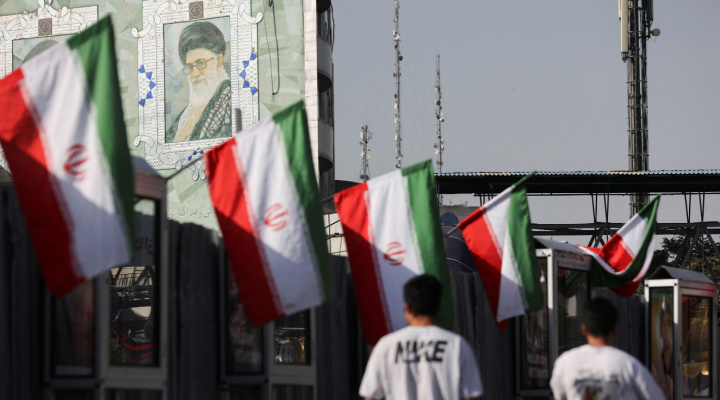People walk near a mural of Iran’s Supreme Leader, Ayatollah Ali Khamenei, amid the Iran-Israel conflict, in Tehran, Iran, June 23, 2025. Photo: Majid Asgaripour/WANA (West Asia News Agency) via REUTERS
The prospect of Iran attacking the US homeland remains a serious threat as it maintains many avenues to pursue should the Islamic regime in Tehran seek to retaliate against Washington for bombing Iranian nuclear facilities in June, according to a new report by a top counter-terrorism analyst.
In the August 2025 issue of CTC Sentinel, a publication of West Point’s Combating Terrorism Center, Matthew Levitt, the Fromer-Wexler senior fellow and director of the Reinhard program on counterterrorism and intelligence at the Washington Institute for Near East Policy, detailed the nature of the threat.
“The 12-day Iran war [with Israel] may be over, but the threat of Iranian reprisal attacks now looms large, and will for the foreseeable future,” Levitt posted Friday on X, summarizing his findings. “Potential pathways for an Iranian attack on the US include deploying Iranian agents, criminal surrogates, terrorist proxies, or actively seeking to inspire lone offenders to carry out attacks within the homeland.”
Following the US strikes on Iran’s nuclear sites, law enforcement agencies across the country ramped up surveillance of Iran-backed operatives amid growing fears of retaliation.
Levitt explained that “Iran and its proxies have spent years investing in a ‘homeland option.’ In just the past five years, US authorities have disrupted at least 17 Iranian plots in the United States. These have included both Iranian operatives as well as criminal proxies. Other cases that fell short of plotting for a specific attack include a Hezbollah operative in Texas who purchased 300 pounds of ammonium nitrate, an explosive precursor, and another who carried out surveillance missions in New York and Canada.”
Iran has also sought to inflame anti-Israel activism.
The CTC Sentinel analysis cited a US Department of Homeland Security report from October 2024 which stated that “Iranian information operations have focused on weakening US public support for Israel and Israel’s response to the Oct. 7, 2023, Hamas terrorist attack [against southern Israel]. These efforts have included leveraging ongoing protests regarding the conflict, posing as activists online, and encouraging protests.”
Levitt noted that top targets of terrorism could include government officials, Iranian dissidents, Israelis, or Jews. “If there were ever a time Iran would want to activate its homeland option, this would be it,” he stated. “But even if the next few weeks pass without any attack, the threat will persist.”
In June, US Attorney General Pam Bondi warned in congressional testimony of the threat posed by Iran-directed terrorism. “We are working hand in hand with all of our agencies to protect Americans and to keep us safe,” she said.
Tehran’s ability to coordinate or inspire attacks on American soil has long been a concern for US law enforcement and intelligence officials — especially the role of so-called “sleeper cells,” covert operatives or terrorists embedded in rival countries who remain dormant until they receive orders to act and carry out attacks.
Levitt described terrorism as “an extension of foreign policy” for Iran, enabling strikes against enemies with superior military capabilities. He quoted a CIA report that stated, “Tehran has used terrorism increasingly to support Iranian national interests.”
However, he also noted that religious fundamentalism still guides the leaders in Tehran too, again citing the CIA which stated the country’s leaders believe Iran “has a religious duty to export its Islamic revolution and to wage, by whatever means, a constant struggle against the perceived oppressor states.”
On Sunday, Iranian Supreme Leader Ayatollah Ali Khamenei expressed this theology which undergirds his regime’s genocidal quest to murder Jews and conquer Israel.
“They want Iran to be obedient to America. The Iranian nation will stand with all of its power against those who have such erroneous expectations,” Khamenei said in a speech, according to Iranian state media. “People who ask us not to issue slogans against the US … to have direct negotiations with the US only see appearances … This issue is unsolvable.”
Khamenei added that “the enemies, after facing the steadfast unity of the nation, officials, and armed forces, and after suffering heavy defeats in military attacks, have realized that Iran and the Islamic system cannot be subdued by war or forced into obedience.”
Levitt noted a Homeland Threat Assessment for 2025 from the Department of Homeland Security which stated, “We expect Iran to remain the primary sponsor of terrorism and continue its efforts to advance plots against individuals — including current and former US officials — in the United States.”
The Jan. 3, 2020, targeted killing of Qassem Soleimani, the commander of the Quds Force of Iran’s Islamic Revolutionary Guard Corps (IRGC), remains a feature of Iranian propaganda with vows to strike at the US officials involved in the decision.
Analyzing a video put out by the regime, Levitt described how “the screen soon pans to a bulletin board covered in images of US officials, including President Trump, former National Security Advisor Robert O’Brien, former Chairman of the Joint Chiefs of Staff General Mark Milley, and about a dozen others. The picture fades, the music crescendos, and text appears on a black screen: ‘The perpetrators of general Soleimani’s martyrdom will be punished for their actions.’”
Click this link for the original source of this article.
Author: David Swindle
This content is courtesy of, and owned and copyrighted by, https://www.algemeiner.com and its author. This content is made available by use of the public RSS feed offered by the host site and is used for educational purposes only. If you are the author or represent the host site and would like this content removed now and in the future, please contact USSANews.com using the email address in the Contact page found in the website menu.





